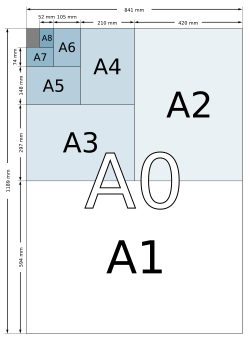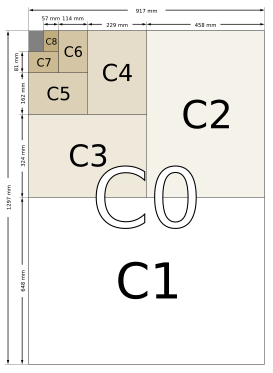ISO 216: Difference between revisions
Bromskloss (talk | contribs) →A, B, C comparison: New size illustrations (and to scale with each other) |
No edit summary |
||
| Line 81: | Line 81: | ||
'''ISO 216''' specifies [[International Organization for Standardization|international standard]] (ISO) [[paper size]]s, used in most countries in the world today. It is the standard which defines the well-known A4 paper size. |
'''ISO 216''' specifies [[International Organization for Standardization|international standard]] (ISO) [[paper size]]s, used in most countries in the world today. It is the standard which defines the well-known A4 paper size. |
||
The international ISO standard is based on the [[Germany|German]] [[Deutsches Institut für Normung|DIN]] standard 476 (''DIN 476'') from 1922. Some of the formats contained therein were independently invented in [[France]] during its revolution and later forgotten. [http://www.cl.cam.ac.uk/~mgk25/loi-timbre.html] The aspect ratio used by this norm was |
The international ISO standard is based on the [[Germany|German]] [[Deutsches Institut für Normung|DIN]] standard 476 (''DIN 476'') from 1922. Some of the formats contained therein were independently invented in [[France]] during its revolution and later forgotten. [http://www.cl.cam.ac.uk/~mgk25/loi-timbre.html] The aspect ratio used by this norm was mentioned in a letter by the German [[Georg Christoph Lichtenberg]] written [[1786-10-25]]. [http://www.cl.cam.ac.uk/~mgk25/lichtenberg-letter.html] |
||
* [[ISO 216]]:1975, defines two series of paper sizes: A and B |
* [[ISO 216]]:1975, defines two series of paper sizes: A and B |
||
Revision as of 09:14, 12 April 2007
| A Series | |
|---|---|
| A0 | 841 × 1189 |
| A1 | 594 × 841 |
| A2 | 420 × 594 |
| A3 | 297 × 420 |
| A4 | 210 × 297 |
| A5 | 148 × 210 |
| A6 | 105 × 148 |
| A7 | 74 × 105 |
| A8 | 52 × 74 |
| A9 | 37 × 52 |
| A10 | 26 × 37 |
| B Series | |
| B0 | 1000 × 1414 |
| B1 | 707 × 1000 |
| B2 | 500 × 707 |
| B3 | 353 × 500 |
| B4 | 250 × 353 |
| B5 | 176 × 250 |
| B6 | 125 × 176 |
| B7 | 88 × 125 |
| B8 | 62 × 88 |
| B9 | 44 × 62 |
| B10 | 31 × 44 |
| C Series | |
| C0 | 917 × 1297 |
| C1 | 648 × 917 |
| C2 | 458 × 648 |
| C3 | 324 × 458 |
| C4 | 229 × 324 |
| C5 | 162 × 229 |
| C6 | 114 × 162 |
| C7/6 | 81 × 162 |
| C7 | 81 × 114 |
| C8 | 57 × 81 |
| C9 | 40 × 57 |
| C10 | 28 × 40 |
| DL | 110 × 220 |
ISO 216 specifies international standard (ISO) paper sizes, used in most countries in the world today. It is the standard which defines the well-known A4 paper size.
The international ISO standard is based on the German DIN standard 476 (DIN 476) from 1922. Some of the formats contained therein were independently invented in France during its revolution and later forgotten. [1] The aspect ratio used by this norm was mentioned in a letter by the German Georg Christoph Lichtenberg written 1786-10-25. [2]
- ISO 216:1975, defines two series of paper sizes: A and B
- ISO 269:1985, defines a C serie for envelopes
- ISO 217:1995, defines two untrimmed series of raw paper sizes: RA and a SRA
A series
Paper in the A series format has a aspect ratio, although this is rounded to the nearest millimetre. A0 is defined so that it has an area of 1 m², prior to the above mentioned rounding. Successive paper sizes in the series (A1, A2, A3, etc.) are defined by halving the preceding paper size parallel to its shorter side, again prior to rounding. The most frequently used paper size is A4 (210 × 297 mm).
B series
The B series formats are geometric means between the A series format with the same number and the A series format with one lower number. For example, B1 is a geometric mean between A1 and A0. The sides of B0 are 1 m to m.
There is also an incompatible Japanese B series defined by the JIS. The lengths of JIS B series paper are approximately 1.22 times those of A-series paper.
C series
The C series formats are geometric means between the B series format with the same number and the A series format with the same number, (e.g., C2 is the geometric mean between B2 and A2). The C series formats are used mainly for envelopes. An A4 page will fit into a C4 envelope. C series envelopes follow the same ratio principle as the A series pages. For example, if an A4 page is folded in half so that it is A5 in size, it will fit into a C5 envelope (which will be the same size as a C4 envelope folded in half).
Tolerances
The tolerances specified in the standard are
- ±1.5 mm for dimensions up to 150 mm,
- ±2 mm for lengths in the range 150 to 600 mm, and
- ±3 mm for any dimension above 600 mm.
A, B, C comparison
| A Series Formats | B Series Formats | C Series Formats | ||||
|---|---|---|---|---|---|---|
| size | mm | inches | mm | inches | mm | inches |
| 0 | 841 × 1189 | 33.1 × 46.8 | 1000 × 1414 | 39.4 × 55.7 | 917 × 1297 | 36.1 × 51.1 |
| 1 | 594 × 841 | 23.4 × 33.1 | 707 × 1000 | 27.8 × 39.4 | 648 × 917 | 25.5 × 36.1 |
| 2 | 420 × 594 | 16.5 × 23.4 | 500 × 707 | 19.7 × 27.8 | 458 × 648 | 18.0 × 25.5 |
| 3 | 297 × 420 | 11.7 × 16.5 | 353 × 500 | 13.9 × 19.7 | 324 × 458 | 12.8 × 18.0 |
| 4 | 210 × 297 | 8.3 × 11.7 | 250 × 353 | 9.8 × 13.9 | 229 × 324 | 9.0 × 12.8 |
| 5 | 148 × 210 | 5.8 × 8.3 | 176 × 250 | 6.9 × 9.8 | 162 × 229 | 6.4 × 9.0 |
| 6 | 105 × 148 | 4.1 × 5.8 | 125 × 176 | 4.9 × 6.9 | 114 × 162 | 4.5 × 6.4 |
| 7 | 74 × 105 | 2.9 × 4.1 | 88 × 125 | 3.5 × 4.9 | 81 × 114 | 3.2 × 4.5 |
| 8 | 52 × 74 | 2.0 × 2.9 | 62 × 88 | 2.4 × 3.5 | 57 × 81 | 2.2 × 3.2 |
| 9 | 37 × 52 | 1.5 × 2.0 | 44 × 62 | 1.7 × 2.4 | 40 × 57 | 1.6 × 2.2 |
| 10 | 26 × 37 | 1.0 × 1.5 | 31 × 44 | 1.2 × 1.7 | 28 × 40 | 1.1 × 1.6 |

|

|

| ||||
Application
Prior to the adoption of ISO 216, many different paper formats were used internationally. These formats did not fit into a coherent system and were defined in terms of non-metric units. The ISO 216 formats are organized around the ratio ; two sheets next to each other together have the same ratio, sideways. This simplifies copying two A4 sheets in reduced size on one, and copying an A4 sheet in magnified size on an A3 sheet or copying half an A4 sheet in magnified size on an A4 sheet. The principal countries not generally using the ISO paper sizes are the United States of America and Canada, which use the Letter, Legal, and Executive system. (Canada uses a P-series of sizes, which are the American paper sizes rounded to metric dimensions.)
Rectangular sheets of paper with the ratio are popular in paper folding, where they are sometimes called "A4 rectangles" or "silver rectangles". [3] (Confusingly, "silver rectangle" can also refer to a rectangle in the proportion ), known as the silver ratio.)
External links
- International standard paper sizes: ISO 216 details and rationale
- ISO 216 at iso.org



